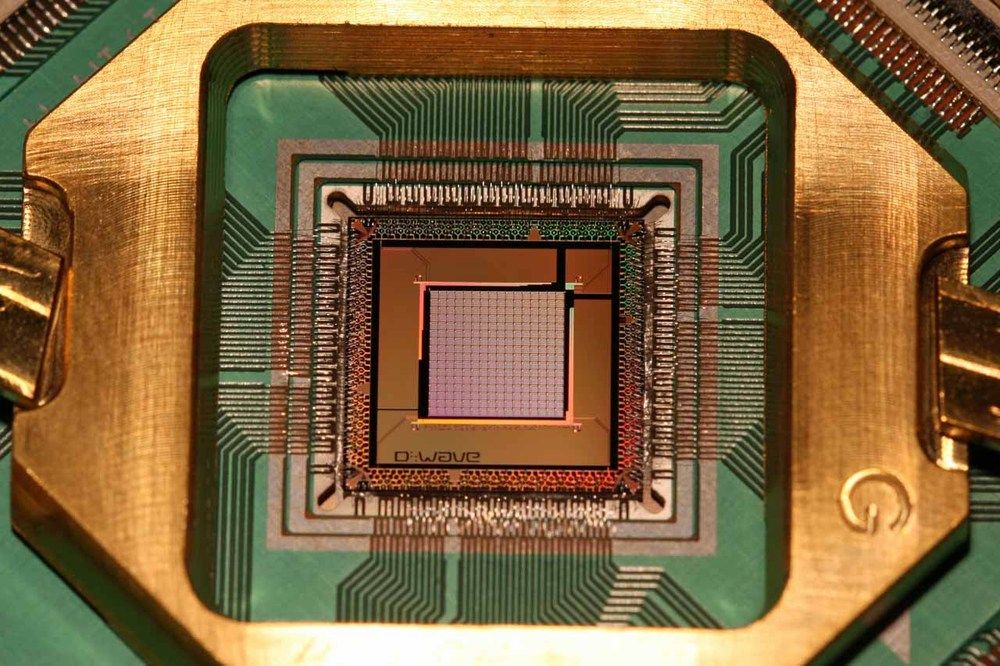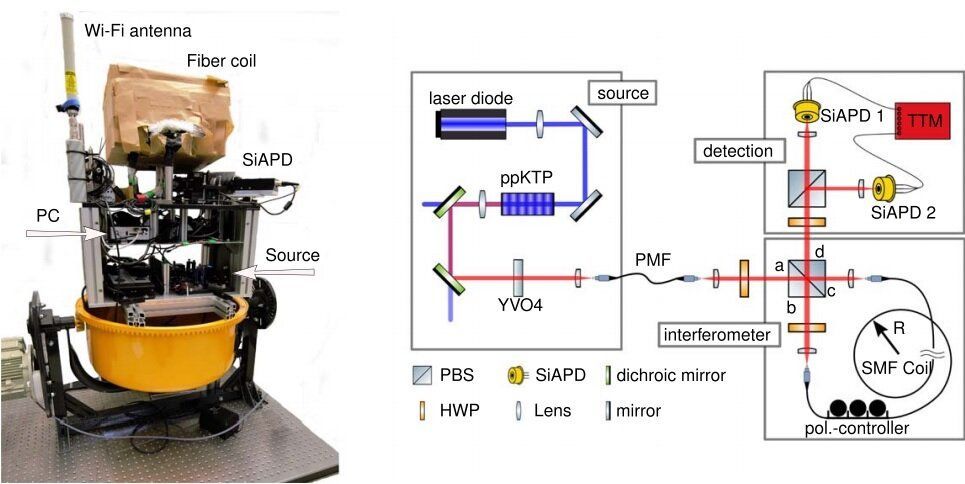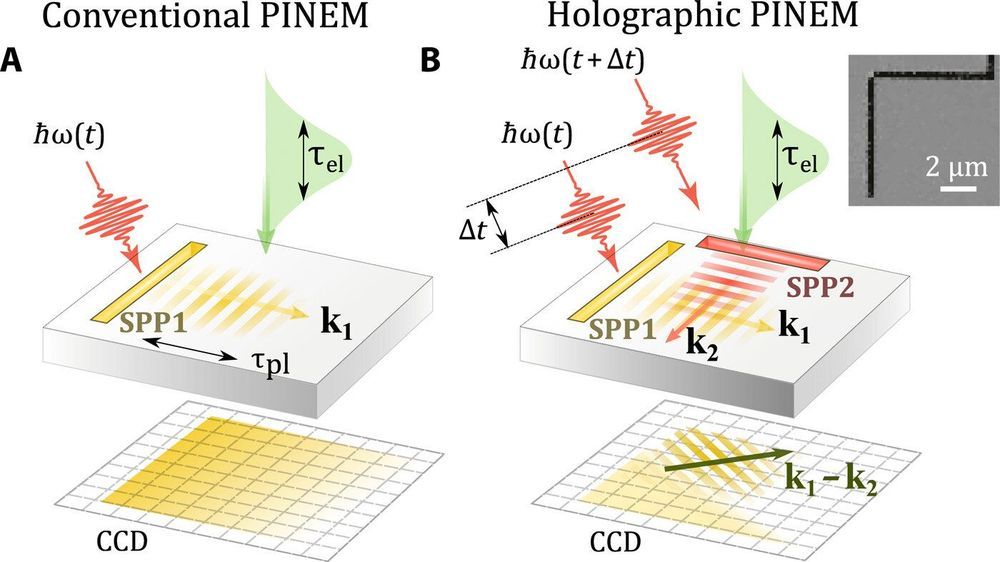
Category: quantum physics – Page 881


Entangled-photon gyroscope overcomes classical limit
Fiber optic gyroscopes, which measure the rotation and orientation of airplanes and other moving objects, are inherently limited in their precision when using ordinary classical light. In a new study, physicists have experimentally demonstrated for the first time that using entangled photons overcomes this classical limit, called the shot-noise limit, and achieves a level of precision that would not be possible with classical light.
The physicists, led by Matthias Fink and Rupert Ursin at the Austrian Academy of Sciences and the Vienna Center for Quantum Science and Technology, have published a paper on the entanglement-enhanced fiber-optic gyroscope in a recent issue of the New Journal of Physics.
“We have demonstrated that the generation of entangled photons has reached a level of technical maturity that enables us to perform measurements with sub-shot noise accuracy in harsh environments,” Fink told Phys.org.

Holographic imaging of electromagnetic fields using electron-light quantum interference
In conventional holography a photographic film can record the interference pattern of monochromatic light scattered from the object to be imaged with a reference beam of un-scattered light. Scientists can then illuminate the developed image with a replica of the reference beam to create a virtual image of the original object. Holography was originally proposed by the physicist Dennis Gabor in 1948 to improve the resolution of an electron microscope, demonstrated using light optics. A hologram can be formed by capturing the phase and amplitude distribution of a signal by superimposing it with a known reference. The original concept was followed by holography with electrons, and after the invention of lasers optical holography became a popular technique for 3D imaging macroscopic objects, information encryption and microscopy imaging.
However, extending holograms to the ultrafast domain currently remains a challenge with electrons, although developing the technique would allow the highest possible combined spatiotemporal resolution for advanced imaging applications in condensed matter physics. In a recent study now published in Science Advances, Ivan Madan and an interdisciplinary research team in the departments of Ultrafast Microscopy and Electron Scattering, Physics, Science and Technology in Switzerland, the U.K. and Spain, detailed the development of a hologram using local electromagnetic fields. The scientists obtained the electromagnetic holograms with combined attosecond/nanometer resolution in an ultrafast transmission electron microscope (UEM).
In the new method, the scientists relied on electromagnetic fields to split an electron wave function in a quantum coherent superposition of different energy states. The technique deviated from the conventional method, where the signal of interest and reference spatially separated and recombined to reconstruct the amplitude and phase of a signal of interest to subsequently form a hologram. The principle can be extended to any kind of detection configuration involving a periodic signal capable of undergoing interference, including sound waves, X-rays or femtosecond pulse waveforms.

Researchers shed new light on atomic ‘wave function’
Physicists have demonstrated a new way to obtain the essential details that describe an isolated quantum system, such as a gas of atoms, through direct observation. The new method gives information about the likelihood of finding atoms at specific locations in the system with unprecedented spatial resolution. With this technique, scientists can obtain details on a scale of tens of nanometers—smaller than the width of a virus.
Experiments performed at the Joint Quantum Institute (JQI), a research partnership between the National Institute of Standards and Technology (NIST) and the University of Maryland, use an optical lattice—a web of laser light that suspends thousands of individual atoms—to determine the probability that an atom might be at any given location. Because each individual atom in the lattice behaves like all the others, a measurement on the entire group of atoms reveals the likelihood of an individual atom to be in a particular point in space.
Published in the journal Physical Review X, the JQI technique (and a similar technique published simultaneously by a group at the University of Chicago) can yield the likelihood of the atoms’ locations at well below the wavelength of the light used to illuminate the atoms—50 times better than the limit of what optical microscopy can normally resolve.



The Thesis on Consciousness and Experiential Realism: Digital Philosophy Perspective
A radically new view articulated now by a number of digital philosophers is that consciousness, quantum computational and non-local in nature, is resolutely computational, and yet, has some “non-computable” properties. Consider this: English language has 26 letters and about 1 million words, so how many books could be possibly written in English? If you are to build a hypothetical computer containing all mass and energy of our Universe and ask it this question, the ultimate computer wouldn’t be able to compute the exact number of all possible combinations of words into meaningful story-lines in billions of years! Another example of non-computability of combinatorics: if you are to be born and live your own life again and again in our Quantum Multiverse, you could live googolplex (10100) lives, but they all would be somewhat different — some of them drastically different from the life you’re living right now, some only slightly — never quite the same, and timeline-indeterminate.
Another kind of non-computability is akin to fuzzy logic but based on pattern recognition. Deeper understanding refers to a situation when a conscious agent gets to perceive numerous patterns in complex environments and analyze that complexity from the multitude of perspectives. That is beautifully encapsulated by Isaiah Berlin’s quote: “To understand is to perceive patterns.” The ability to recognize patterns in chaos is not straightforwardly algorithmic but rather meta-algorithmic and yet, I’d argue, deeply computational. The types of non-computability that I just described may somehow relate to the non-computable element of quantum consciousness to which Penrose refers in his work.

Physicists Are Starting to Suspect Physical Reality Is an Illusion
Given that everything at its base atom is moving maybe our interpretation of reality may be different than its actuality. From shooting photons bouncing off surfaces the world is a cacophony of all sorts of things happening at once.
A provocative new column in Scientific American floats the idea that what’s fundamentally real in the universe — its actual, base reality — isn’t the quarks, fields, and quantum phenomena that seem to comprise it.
Instead, according to scientist and philosopher Bernardo Kastrup, some are starting to suspect that matter itself is an illusion — and that the only real thing is information.
Information Space
The basic idea is that the physical universe exists because we perceive it — it’s a sort of mass hallucination we use to make sense of the mathematical relationships of objects.

Researchers successfully sent a simulated elementary particle back in time
The results are fascinating and spur the imagination, but don’t start investing in flux capacitors yet. This experiment also shows us that sending even a simulated particle back in time requires serious outside manipulation. To create such an external force to manipulate even one physical particle’s quantum waves is well beyond our abilities.
“We demonstrate that time-reversing even ONE quantum particle is an unsurmountable task for nature alone,” study author Vinokur wrote to the New York Times in an email [emphasis original]. “The system comprising two particles is even more irreversible, let alone the eggs — comprising billions of particles — we break to prepare an omelet.”
A press release from the Department of Energy notes that for the “timeline required for [an external force] to spontaneously appear and properly manipulate the quantum waves” to appear in nature and unscramble an egg “would extend longer than that of the universe itself.” In other words, this technology remains bound to quantum computation. Subatomic spas that literally turn back the clock aren’t happening.

